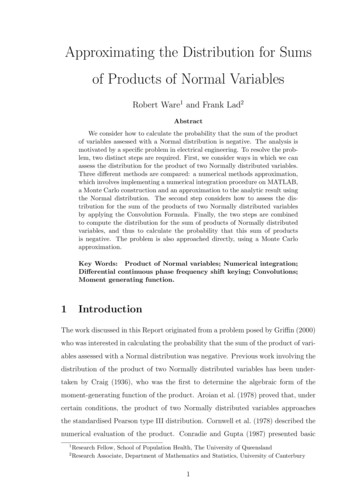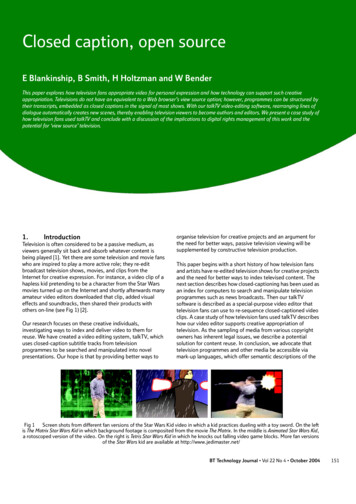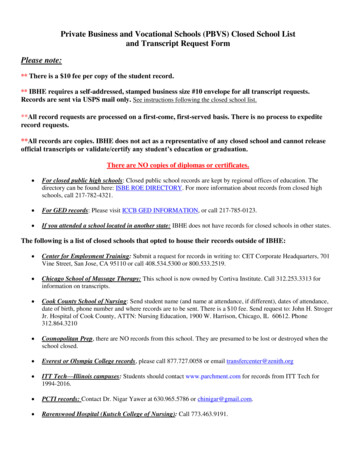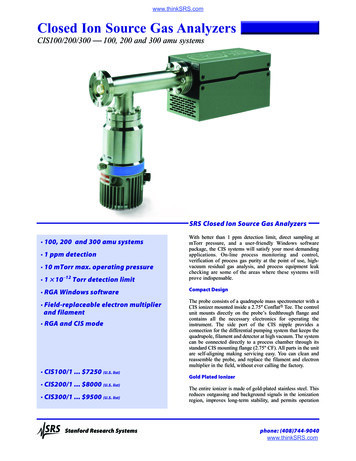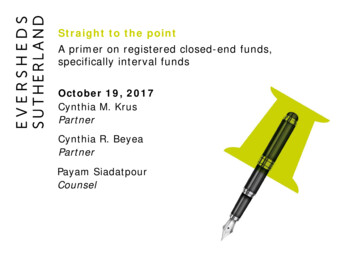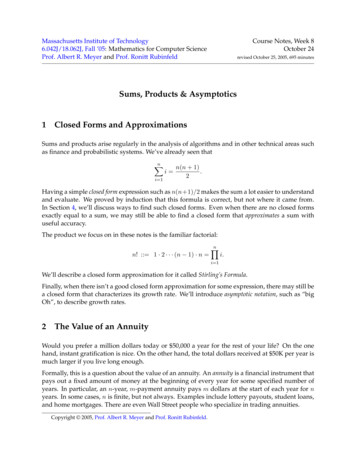
Transcription
Massachusetts Institute of Technology6.042J/18.062J, Fall ’05: Mathematics for Computer ScienceProf. Albert R. Meyer and Prof. Ronitt RubinfeldCourse Notes, Week 8October 24revised October 25, 2005, 695 minutesSums, Products & Asymptotics1Closed Forms and ApproximationsSums and products arise regularly in the analysis of algorithms and in other technical areas suchas finance and probabilistic systems. We’ve already seen thatn i 1i n(n 1).2Having a simple closed form expression such as n(n 1)/2 makes the sum a lot easier to understandand evaluate. We proved by induction that this formula is correct, but not where it came from.In Section 4, we’ll discuss ways to find such closed forms. Even when there are no closed formsexactly equal to a sum, we may still be able to find a closed form that approximates a sum withuseful accuracy.The product we focus on in these notes is the familiar factorial:n! :: 1 · 2 · · · (n 1) · n n i.i 1We’ll describe a closed form approximation for it called Stirling’s Formula.Finally, when there isn’t a good closed form approximation for some expression, there may still bea closed form that characterizes its growth rate. We’ll introduce asymptotic notation, such as “bigOh”, to describe growth rates.2 The Value of an AnnuityWould you prefer a million dollars today or 50,000 a year for the rest of your life? On the onehand, instant gratification is nice. On the other hand, the total dollars received at 50K per year ismuch larger if you live long enough.Formally, this is a question about the value of an annuity. An annuity is a financial instrument thatpays out a fixed amount of money at the beginning of every year for some specified number ofyears. In particular, an n year, m payment annuity pays m dollars at the start of each year for nyears. In some cases, n is finite, but not always. Examples include lottery payouts, student loans,and home mortgages. There are even Wall Street people who specialize in trading annuities.Copyright 2005, Prof. Albert R. Meyer and Prof. Ronitt Rubinfeld.
2Course Notes, Week 8: Sums, Products & AsymptoticsA key question is what an annuity is worth. For example, lotteries often pay out jackpots overmany years. Intuitively, 50, 000 a year for 20 years ought to be worth less than a million dollarsright now. If you had all the cash right away, you could invest it and begin collecting interest. Butwhat if the choice were between 50, 000 a year for 20 years and a half million dollars today? Nowit is not clear which option is better.In order to answer such questions, we need to know what a dollar paid out in the future is worthtoday. To model this, let’s assume that money can be invested at a fixed annual interest rate p.We’ll assume an 8% rate1 for the rest of the discussion.Here is why the interest rate p matters. Ten dollars invested today at interest rate p will become(1 p) · 10 10.80 dollars in a year, (1 p)2 · 10 11.66 dollars in two years, and so forth. Lookedat another way, ten dollars paid out a year from now are only really worth 1/(1 p) · 10 9.26dollars today. The reason is that if we had the 9.26 today, we could invest it and would have 10.00 in a year anyway. Therefore, p determines the value of money paid out in the future.2.1The Future Value of MoneyOur goal is to determine the value of an n year, m payment annuity. The first payment of mdollars is truly worth m dollars. But the second payment a year later is worth only m/(1 p)dollars. Similarly, the third payment is worth m/(1 p)2 , and the n th payment is worth onlym/(1 p)n 1 . The total value V of the annuity is equal to the sum of the payment values. Thisgives:n mV .(1 p)i 1i 1To compute the real value of the annuity, we need to evaluate this sum. One way is to plugin m, n, and p, compute each term explicitly, and then add them up. However, this sum has aspecial closed form that makes the job easier. (The phrase “closed form” refers to a mathematicalexpression without any summation or product notation.) First, lets make the summation prettierwith some substitutions.V n i 1n 1 j 0 mm(1 p)i 1m(1 p)jn 1 j 0xj(substitute j i 1)(substitute x 1).1 pThe goal of these substitutions is to put the summation into a special form so that we can bash itwith a theorem given in the next section.1U.S. interest rates have dropped steadily for several years, and ordinary bank deposits now earn around 3%. Butjust a few years ago the rate was 8%; this rate makes some of our examples a little more dramatic. The rate has been ashigh as 17% in the past twenty years.In Japan, the standard interest rate is near zero%, and on a few ocasions in the past few years has even been slightlynegative. It’s a mystery to U.S. economists why the Japanese populace keeps any money in their banks.
Course Notes, Week 8: Sums, Products & Asymptotics2.23Geometric SumsTheorem 2.1. For all n 1 and all x 1,n 1 1 xn.1 xxi i 0The summation in this theorem is a geometric sum. The distinguishing feature of a geometric sumis that each of the terms1, x, x2 , x3 , . . . , xn 1 .in the sum is a constant times the one before; in this case, the constant is x. The theorem gives aclosed form for a geometric sum that starts with 1.We already saw one proof of this theorem in our lectures on induction. As is often the case, theproof by induction gives no hint about how the formula was found in the first place. Here is amore insightful derivation. The trick is to let S be the value of the sum and then observe what xS is:S 1 x x2 x3 · · · xn 1 xS x x2 x3 · · · xn 1 xn .Adding these two equations gives:S xS 1 xn ,soS 1 xn.1 xWe’ll say more about finding (as opposed to just proving) summation formulas later.2.3 Return of the Annuity ProblemNow we can solve the annuity pricing problem. The value of an annuity that pays m dollars atthe start of each year for n years is computed as follows:V mn 1 xjj 01 xn m1 x1 n1 ( 1 p) m11 1 p m1 n 11 p ( 1 p)p.The first line is a restatement of the summation we obtained earlier for the value of an annuity.The second line uses the closed form formula for a geometric sum. In the third line, we undo
4Course Notes, Week 8: Sums, Products & Asymptoticsthe earlier substitution x 1/(1 p). In the final step, both the numerator and denominator aremultiplied by 1 p to simplify the expression.The resulting formula is much easier to use than a summation with dozens of terms. For example,what is the real value of a winning lottery ticket that pays 50, 000 per year for 20 years? Pluggingin m 50, 000, n 20, and p 0.08 gives V 530, 180. Because payments are deferred, themillion dollar lottery is really only worth about a half million dollars! This is a good trick for thelottery advertisers!2.4 Infinite Geometric SeriesThe question at the beginning of this section was whether you would prefer a million dollarstoday or 50, 000 a year for the rest of your life. Of course, this depends on how long you live, sooptimistically assume that the second option is to receive 50, 000 a year forever. This sounds likeinfinite money!We can compute the value of an annuity with an infinite number of payments by taking the limitof our geometric sum in Theorem 2.1 as n tends to infinity. This one is worth remembering!Theorem 2.2. If x 1, then xi i 01.1 xProof. xi i 0limn n 1 xii 01 xnn 1 x1 .1 x limThe first equality follows from the definition of an infinite summation. In the second line, weapply the formula for the sum of an n term geometric sum given in Theorem 2.1. The final linefollows by evaluating the limit; the xn term vanishes since we assumed that x 1.In our annuity problem, x 1/(1 p) 1, so the theorem applies. Substituting for x, we get anannuity value ofV m·11 x11 1/(1 p)1 p m·(1 p) 11 p m·.p m·
Course Notes, Week 8: Sums, Products & Asymptotics5Plugging in m 50, 000 and p 0.08 gives only 675, 000. Amazingly, a million dollars today isworth much more than 50, 000 paid every year forever! Then again, if we had a million dollarstoday in the bank earning 8% interest, we could take out and spend 80, 000 a year forever. So theanswer makes some sense.2.5 ExamplesWe now have closed form formulas for geometric sums and series. Some examples are givenbelow. In each case, the solution follows immediately from either Theorem 2.1 (for finite sums) orTheorem 2.2 (for infinite series).1 1/2 1/4 1/8 · · · (1/2)i i 00.999999999 . . . 0.9 (1/10)i 0.9i 01 1/2 1/4 1/8 · · · 1 2 4 8 · · · 2n 1 1 3 9 27 · · · 3n 1 i 0n 1 i 0110 0.9 11 1/109(1)(2) 1 2/31 ( 1/2)(3)2i 1 2n 2n 11 2(4)3i 1 3n 3n 1 1 32(5)( 1/2)ii 0n 1 1 21 (1/2)If the terms in a geometric sum or series grow smaller, as in equation (1), then the sum is said tobe geometrically decreasing. If the terms in a geometric sum grow progressively larger, as in (4) and(5), then the sum is said to be geometrically increasing.Here is a good rule of thumb: a geometric sum or series is approximately equal to the term with greatestabsolute value. In equations (1) and (3), the largest term is equal to 1 and the sums are 2 and 2/3,both relatively close to 1. In equation (4), the sum is about twice the largest term. In the finalequation (5), the largest term is 3n 1 and the sum is (3n 1)/2, which is only about a factor of 1.5greater.2.6 Related SumsWe now know all about geometric sums. But in practice one often encounters sums that cannot betransformed by simple variable substitutions to the form xi .A non obvious, but useful way to obtain new summation formulas from old is by differentiatingor integrating with respect to x. As an example, consider the following sum:n ixi x 2x2 3x3 · · · nxni 1This is not a geometric sum, since the ratio between successive terms is not constant. Our formulafor the sum of a geometric sum cannot be directly applied. But suppose that we differentiate that
6Course Notes, Week 8: Sums, Products & Asymptoticsformula:nd ix dxi 0n ixi 1 i 1 d 1 xn 1dx 1 x (n 1)xn (1 x) ( 1)(1 xn 1 )(1 x)2 (n 1)xn (n 1)xn 1 1 xn 1(1 x)2n1 (n 1)x nxn 1.(1 x)2Often differentiating or integrating messes upexponent of x in every term. In this case, the wenow have a formula for a sum of the formixi 1 , but we want a formula for the seriesixi .The solution is simple: multiply by x. This gives:n ixi i 1x (n 1)xn 1 nxn 2(1 x)2Since we could easily have made a mistake, it is a good idea to go back and validate a formulaobtained this way with a proof by induction.Notice that if x 1, then this series converges to a finite value even if there are infinitely manyterms. Taking the limit as n tends infinity gives the following theorem:Theorem 2.3. If x 1, then ixi i 1x.(1 x)2As a consequence, suppose there is an annuity that pays im dollars at the end of each year i forever.For example, if m 50, 000, then the payouts are 50, 000 and then 100, 000 and then 150, 000and so on. It is hard to believe that the value of this annuity is finite! But we can use the precedingtheorem to compute the value:V i 1 mim(1 p)i11 p1 2 1 p)(11 p m 2 .pThe second line follows by an application of Theorem 2.3. The third line is obtained by multiplyingthe numerator and denominator by (1 p)2 .For example, if m 50, 000, and p 0.08 as usual, then the value of the annuity is V 8, 437, 500. Even though payments increase every year, the increase is only additive with time; bycontrast, dollars paid out in the future decrease in value exponentially with time. The geometric
Course Notes, Week 8: Sums, Products & Asymptotics7decrease swamps out the additive increase. Payments in the distant future are almost worthless,so the value of the annuity is finite.The important thing to remember is the trick of taking the derivative (or integral) of a summationformula. Of course, this technique requires one to compute nasty derivatives correctly, but this isat least theoretically possible!3Book StackingSuppose you have a pile of books and you want to stack them on a table in some off center wayso the top book sticks out past books below it. How far past the edge of the table do you thinkyou could get the top book to go without having the stack fall over? Could the top book stick outcompletely beyond the edge of table?Most people’s first response to this question—sometimes also their second and third responses—is “No, the top book will never get completely past the edge of the table.” But in fact, you canget the top book to stick out as far as you want: one booklength, two booklengths, any number ofbooklengths!3.1Formalizing the ProblemWe’ll approach this problem recursively. How far past the end of the table can we get one book tostick out? It won’t tip as long as its center of mass is over the table, so we can get it to stick outhalf its length, as shown in Figure 1.center of massof book12tableFigure 1: One book can overhang half a book length.Now suppose we have a stack of books that will stick out past the table edge without tippingover—call that a stable stack. Let’s define the overhang of a stable stack to be the largest horizontaldistance from the center of mass of the stack to the furthest edge of a book. If we place the centerof mass of the stable stack at the edge of the table as in Figure 2, that’s how far we can get a bookin the stack to stick out past the edge.So we want a formula for the maximum possible overhang, Bn , achievable with a stack of n books.
8Course Notes, Week 8: Sums, Products & Asymptoticscenter of massof the whole stackoverhangtableFigure 2: Overhanging the edge of the table.We’ve already observed that the overhang of one book is 1/2 a book length. That is,1B1 .2Now suppose we have a stable stack of n 1 books with maximum overhang. If the overhangof the n books on top of the bottom book was not maximum, we could get a book to stick outfurther by re
Sums, Products & Asymptotics 1 Closed Forms and Approximations Sums and products arise regularly in the analysis of algorithms and in other technical areas such as finance and probabilistic systems. We’ve already seen that n n(n 1) i 2. i 1 Having a simple closed form expression such as n(n 1)/2makes the sum a lot easier to understand and evaluate. We proved by induction that this
